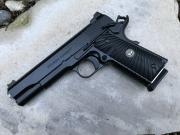So gas port can play a factor as well is what I get from the above.
Do you have anything to quantify this (not questioning just curious). Like 10.3 at .070” versus 11.5 at .075” or whatever.
Is it fair to say that it would cause a 10%, 50% or no difference for example?
I just read disingenuous and wonder how we have been misled and if so by how much?
What do you think?



 Reply With Quote
Reply With Quote







